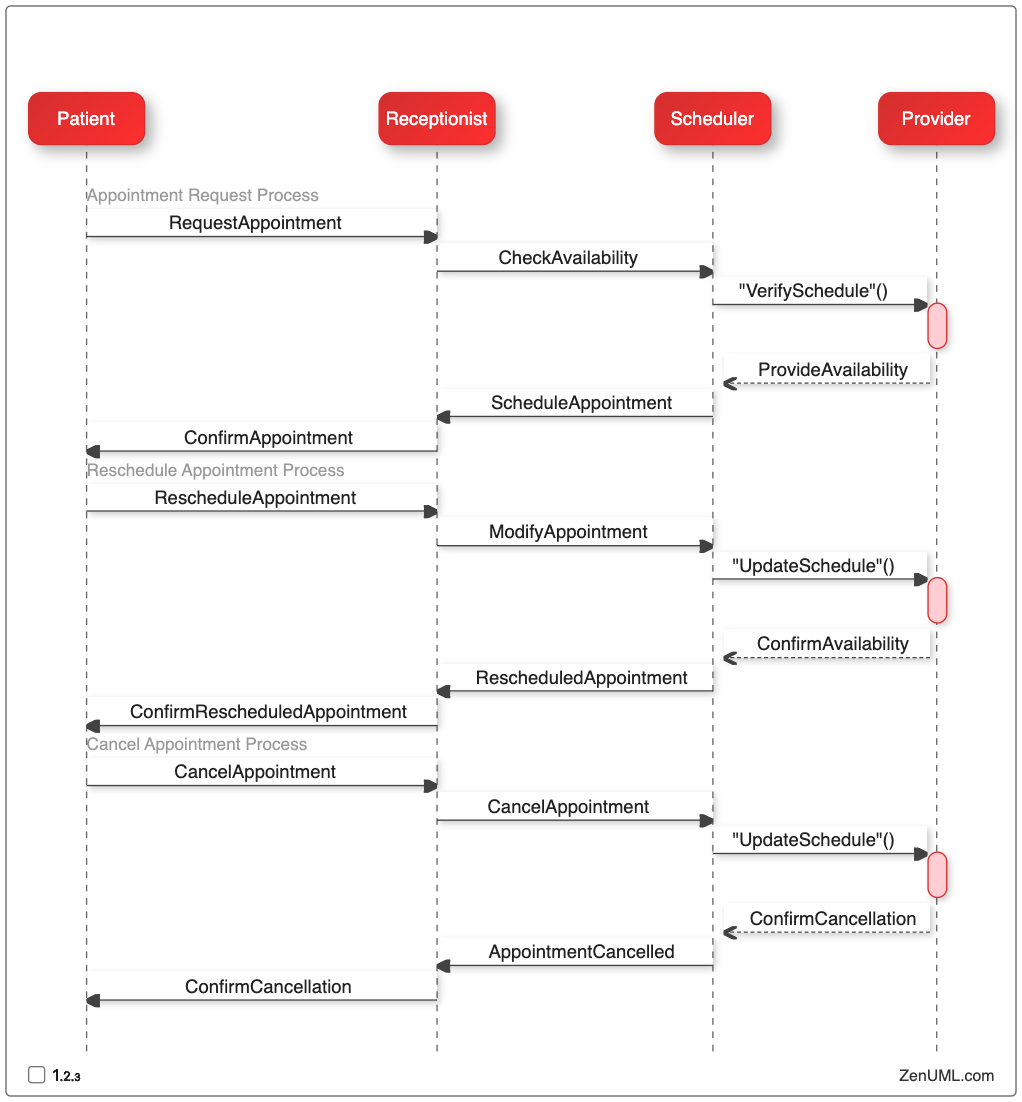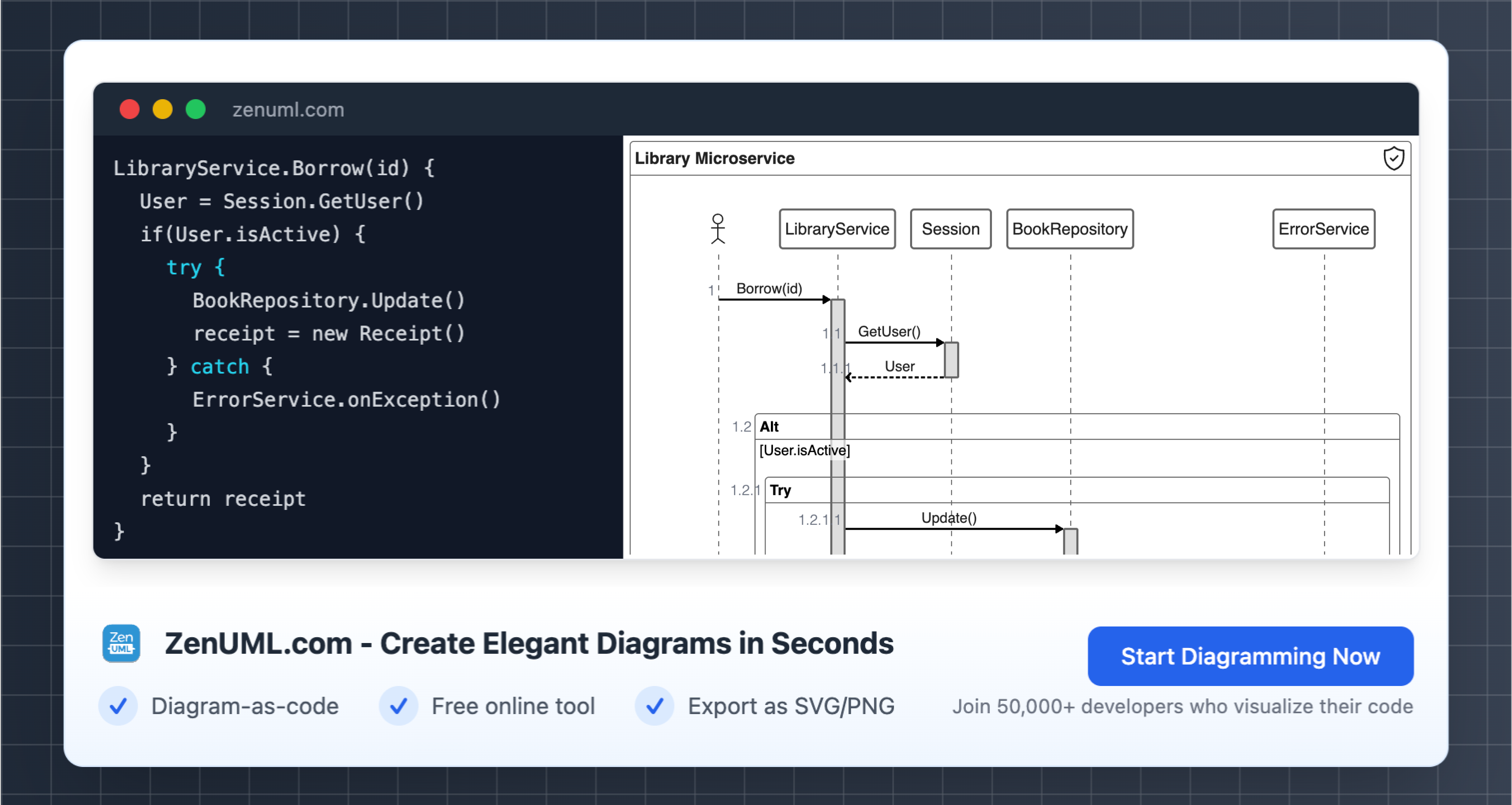Introduction
Healthcare appointment scheduling is a critical component of patient care, ensuring that individuals receive the necessary medical attention in a timely and efficient manner. However, the process of scheduling appointments can often be complex and fraught with challenges, leading to frustration for both patients and healthcare providers. This is where business process modeling (BPM) comes into play, offering a powerful tool to optimize and streamline healthcare appointment scheduling.
In this blog post, we will explore how business process modeling can be leveraged to enhance the healthcare appointment scheduling experience. We'll delve into the key benefits of BPM, discuss practical examples, and even showcase a sequence diagram using ZenUML to illustrate the process. By the end of this article, you'll have a deeper understanding of how BPM can transform the way healthcare organizations manage their appointment scheduling workflows.
The Importance of Business Process Modeling in Healthcare Appointment Scheduling
Business process modeling (BPM) is a methodical approach to analyzing, visualizing, and optimizing the workflows and procedures that underpin an organization's operations. In the context of healthcare appointment scheduling, BPM can play a crucial role in improving the overall efficiency and patient satisfaction.
Increased Efficiency and Productivity
One of the primary benefits of BPM in healthcare appointment scheduling is its ability to enhance efficiency and productivity. By mapping out the various steps involved in the scheduling process, healthcare providers can identify bottlenecks, redundancies, and opportunities for streamlining. This can lead to reduced wait times for patients, better resource utilization, and improved staff productivity.
Enhanced Patient Experience
BPM also helps to improve the patient experience by ensuring that the appointment scheduling process is seamless and user-friendly. By understanding the patient's perspective and pain points, healthcare organizations can design scheduling workflows that are intuitive, responsive, and aligned with patient needs. This can lead to increased patient satisfaction, higher appointment attendance rates, and better health outcomes.
Data-Driven Decision Making
Business process modeling provides healthcare organizations with valuable data and insights that can inform decision-making. By tracking key performance indicators (KPIs) such as appointment no-show rates, patient wait times, and resource utilization, healthcare providers can identify areas for improvement and make data-driven decisions to optimize their scheduling processes.
Compliance and Risk Mitigation
Healthcare appointment scheduling is subject to a range of regulatory requirements and patient privacy concerns. BPM can help healthcare organizations ensure compliance with relevant laws and industry standards, while also mitigating the risks associated with scheduling errors or data breaches.
Practical Examples of BPM in Healthcare Appointment Scheduling
To illustrate the practical applications of BPM in healthcare appointment scheduling, let's explore a few real-world examples:
Example 1: Streamlining the Online Appointment Booking Process
A large healthcare network recognized that its online appointment booking system was causing frustration for patients due to its complex and confusing interface. By applying BPM principles, the organization was able to map out the entire booking process, identify pain points, and redesign the user experience.
The new online booking system featured a clean, intuitive layout, with clear step-by-step instructions and real-time availability updates. Patients could easily search for providers, view open appointment slots, and complete the booking process in just a few clicks. As a result, the organization witnessed a 25% increase in online appointment bookings, a 20% reduction in call center inquiries, and an overall improvement in patient satisfaction scores.
Example 2: Optimizing Scheduling for Specialty Clinics
A specialized healthcare clinic serving a diverse patient population was facing challenges in managing its appointment scheduling. Patients often experienced long wait times, and the clinic struggled to efficiently allocate resources across different specialty areas.
By implementing BPM, the clinic was able to map out the entire scheduling workflow, from patient intake to provider availability and resource allocation. This led to the development of a centralized scheduling system that leveraged advanced algorithms to match patient needs with provider expertise and availability.
The new scheduling process resulted in a 15% reduction in patient wait times, a 12% increase in provider productivity, and a 30% improvement in patient satisfaction scores. The clinic also reported better coordination between specialty areas, leading to improved continuity of care for patients.
Example 3: Integrating Appointment Reminders and Patient Notifications
A healthcare organization recognized that missed appointments were a significant challenge, leading to wasted resources, delayed care, and unhappy patients. By applying BPM, the organization identified key touchpoints where patient communication could be improved.
The organization implemented an automated appointment reminder system, sending personalized notifications to patients via email, text, and voice messages. Additionally, the BPM process revealed opportunities to proactively notify patients of any schedule changes or delays, ensuring that they could make informed decisions about their healthcare.
The results were impressive: the organization experienced a 35% reduction in no-show rates, a 20% increase in appointment attendance, and a 15% improvement in patient satisfaction scores. Patients also reported feeling more engaged and informed throughout the scheduling process.
Sequence Diagram: Visualizing the Healthcare Appointment Scheduling Process
To further illustrate the healthcare appointment scheduling process using business process modeling, let's create a sequence diagram using ZenUML, a popular diagramming language.

In this sequence diagram, we can see the key steps involved in the healthcare appointment scheduling process, including:
- Patient requests an appointment with the receptionist.
- Receptionist checks the availability with the scheduler.
- Scheduler verifies the provider's schedule and provides availability.
- Scheduler communicates the scheduled appointment back to the receptionist, who then confirms the appointment with the patient.
- Patient can reschedule or cancel the appointment, with the receptionist, scheduler, and provider collaborating to update the schedule accordingly.
By visualizing the healthcare appointment scheduling process in this way, healthcare organizations can better understand the interactions between different stakeholders, identify areas for improvement, and optimize the overall workflow.
Conclusion
In the dynamic and ever-evolving landscape of healthcare, the ability to streamline appointment scheduling is crucial for delivering high-quality patient care. Business process modeling has emerged as a powerful tool to enhance the efficiency and effectiveness of healthcare appointment scheduling, leading to improved patient satisfaction, increased provider productivity, and better overall healthcare outcomes.
Through the practical examples and the ZenUML sequence diagram presented in this article, we've explored how BPM can be leveraged to tackle common challenges in healthcare appointment scheduling. By mapping out the entire process, identifying bottlenecks, and implementing data-driven solutions, healthcare organizations can create a more seamless and patient-centric scheduling experience.
As you continue to explore the benefits of business process modeling in healthcare, we encourage you to share your own experiences and insights in the comments below. Your feedback and perspectives can help us further understand the transformative potential of BPM in the healthcare industry.
Try ZenUML now!
Zenuml detailed feature roadmap available here.

